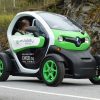Magnetic Concrete Could Enable Electric Cars to Drive Indefinitely
As early as the 19th century, electric cars were primed to take over the automotive industry and change the face of travel forever, specifically when it came to speed. In fact, an electric car held the land speed record until the early 20th century.
However, for the rest of the 1900s, the popularity of electric cars waned, stagnating the progress of electric vehicle technology. In the past two decades, the industry has begun to make a resurgence, but it still has major drawbacks. Similarly to their gas-powered counterparts having to stop and refuel, electric cars have to stop and recharge.
Wouldn’t it be great if electric cars were like the latest cell phones though? You could park them on any surface, and they would charge wirelessly –– no cables, no outlets.
This is a concept German startup Magment has turned into a reality. Magment’s product, also called “magment,” allows for dynamic charging so that electric cars can recharge while in motion. Theoretically, under the right conditions, you could drive from New York to Los Angeles without making a single pit stop.
How Magment’s Made
Magment is a blend of the words “magnet” and “cement,” so it is aptly named! This product has all the qualities of cement –– it starts off as a liquid and dries hard, allowing people to walk on it and cars to drive over it. It’s made by combining concrete with ferrite particles that are recycled from electronic waste within the ferrite industry. Doing this results in a ferromagnetic surface that constantly generates a low-level magnetic field in the presence of an electric current.
While this magnetic field isn’t strong enough to interfere with pacemakers or other sensitive electronics, it is strong enough to recharge an electric vehicle.
How Dynamic Charging Works
Dynamic charging is a lot like wireless phone charging, but it allows for greater distance between charger and device. According to Magment, when a magnetic field is emitted via the magment road, it induces an electric current in a receiving coil under the car. The coil is connected to a battery, which recharges as needed.
This is a technology that also works on busses and trucks, with one small setback. Because they have a higher clearance, the magnetic field is weaker by the time it reaches them. This means the vehicles will need more time to fully recharge.
Given enough time for the infrastructure to adapt, we may one day slash the country’s vehicle-related pollution by powering all vehicles on the road with the road itself.
Magnetism with Apex Magnets
While magment is great for outdoor applications, Apex Magnets’ permanent rare earth elements are ideal for use in offices, warehouses, and factories. Look through our catalogue for a full list of products and contact our friendly sales staff for recommendations!

